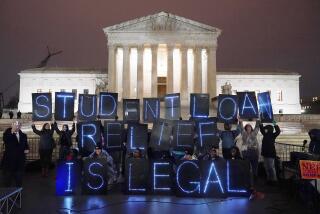Problems With Kaczynski Defense Are Increasingly Clear
While attorneys in the Unabomber case go back to court today for yet another round of legal fighting, the challenge of mounting a strong defense for suspect Theodore Kaczynski has emerged more clearly than at any time since his arrest at a remote Montana shack in 1996.
Federal prosecutors and defense attorneys have repeatedly clashed over whether the government could have its own psychiatrists examine Kaczynski and the terms of that examination.
U.S. District Judge Garland E. Burrell Jr. had ordered the examination to take place last Saturday. But at the eleventh hour last Friday, Kaczynski balked and refused to submit to the court-ordered mental evaluation.
Legal analysts say that decision is likely to be costly to Kaczynski, citing the possibility that Burrell could limit the use of defense mental experts who reportedly have diagnosed the Chicago native as a paranoid schizophrenic.
“It raises a big question, not yet answered . . . as to whether or not the judge shall penalize him by denying him the ability to introduce his [own mental health] experts,” said Joshua Dressler, a professor of law at Sacramento’s McGeorge University School of Law.
Loyola University Law School Associate Dean Laurie Levenson said the latest turn of events was not surprising.
“It’s unclear [whether] Kaczynski wants to be saved, at least in the way his lawyers want [him] to be,” Levenson said.
His attorneys, she said, are trying to bring every possible defense, but “he doesn’t necessarily see it in his interest. The man may be a little bit self-destructive.”
Even while shrugging off such criticism, Quin Denvir, Kaczynski’s Sacramento-based federal public defender, acknowledged that “it obviously causes some problems . . . in how you would otherwise put on that evidence.”
In an interview this week, Denvir said it would be difficult to gauge the significance of Kaczynski’s refusal until Burrell imposes sanctions, if any. Denvir said he told the judge that “we would suffer whatever the consequences are.”
Questions about Kaczynski’s mental condition could come up at today’s hearing, which is scheduled to air arguments over the government’s decision to seek the death penalty against the former UC Berkeley mathematics professor.
Meanwhile, a 92-page prosecution trial brief filed last week poses still other potential hurdles for the defense.
The document spells out--sometimes in Kaczynski’s own words--how he is linked to a 17-year bombing rampage in which three people were killed and more than two dozen injured.
Over the years, as they tried to unravel the mystery of the bombings, FBI agents gave the bomber the code name “Unabom” because the early targets were university campuses and airlines.
In Sacramento, Kaczynski, 55, is charged with 10 bomb-related offenses, including the attack that killed Sacramento computer store owner Hugh Scrutton in 1985 and a blast a decade later in which timber industry lobbyist Gilbert Murray died near the state Capitol.
The other charges relate to bombs that seriously injured UC San Francisco geneticist Charles Epstein and Yale University computer scientist David Gelernter. Kaczynski has pleaded not guilty.
In the redacted trial brief filed by the U.S. attorney’s office, prosecutors revealed in the clearest terms yet that during the search of Kaczynski’s Montana cabin in April 1996 they found evidence tying Kaczynski to Scrutton’s slaying. In particular, they found a personal journal that cited the blast that killed Scrutton on Dec. 11, 1985.
“EXPERIMENT 97. DEC. 11, 1985. I PLANTED BOMB DISGUISED TO LOOK LIKE SCRAP OF LUMBER BEHIND RENTECH COMPUTE STORE IN SACRAMENTO,” the entry said.
“ACCORDING TO SAN FRANCISCO EXAMINER, DEC. 20, THE ‘OPERATOR’ (OWNER? MANAGER?) OF THE STORE WAS KILLED, ‘BLOWN TO BITS,’ ON DEC. 12.”
Kacyznski described constructing a bomb during October and November 1985, and completing it Dec. 8. The passage concludes:
“The device was hidden inside a hollow piece of wood so that when the wood were to be grabbed or picked up, the bolts in the trigger would come out. The device was deployed on Dec. 11.”
To further buttress their case, prosecutors noted, as they had done previously, they found a fully functional bomb during the search of Kaczynski’s cabin in April 1996. They want the discovery of the “Unabomb-type bomb” admitted as evidence.
Loyola’s Levenson described the prosecution trial brief as “just devastating.”
“If you are a defense lawyer, you wonder if there’s a light at the end of the tunnel. This is as dead-bang as it gets.”
This week, prosecutors also renewed their call to be allowed to present evidence of other bombings allegedly committed by Kaczynski, but for which he has not been charged in Sacramento.
They are seeking to use the other bombings and the cabin bomb to show that Kaczynski committed all the crimes attributed to the Unabomber “and to establish the defendant’s intent to kill his victims.”
Prosecutors complained to Burrell that Kacyznski’s attorneys had failed to respond promptly to the government’s request to use this material during the trial, which is set to begin Nov. 12 with jury selection.
“Of course, we’ve responded,” said Denvir, citing his objections to the introduction of alleged criminal activities not charged in Sacramento.
“They are getting a little hysterical over there,” he said.
Although Kaczynski’s court-appointed team of attorneys are mounting a spirited defense, outside legal analysts say they appear to face an almost insurmountable wall in the guilt phase of the trial.
“Of all the ‘trials of the century,’ ” Levenson said, “this one has the most overwhelming evidence. So [the defense is] going to have to really pull a rabbit out of the hat.”
More to Read
Sign up for Essential California
The most important California stories and recommendations in your inbox every morning.
You may occasionally receive promotional content from the Los Angeles Times.






